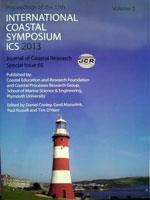ERM, A., BUSCHMANN, F., LISTAK, M., REBANE, J., and TOMING, G., 2013. Underwater experiments and a theoretical model – case study in Tallinn Bay. In: Conley, D.C., Masselink, G., Russell, P.E. and O'Hare, T.J. (eds.)
The aim of this study was to experimentally validate a theoretical shear stress model for calculating critical shear velocities that cause sediment resuspension and bed load transport. Long period measurements with an acoustic Doppler velocimeter were carried out in the Tallinn Bay, in three stations with different bottom geology. Water turbidity was measured at the same level and a camera system was used to register sediment resuspension. Measurements showed that a detailed model must be used in case of strong interactions of waves and currents near the bottom. If currents are weak then a simple Nielsen model can be used to estimate sediment resuspension conditions. Thickness of the bottom boundary layer was found being 1 – 10 cm and the skin friction layer being 0.07 - 0.7 cm. A pilot study using constructed autonomous underwater particle image velocimetry device (PIV) showed that the upper part of bottom boundary layer i.e. the wave boundary layer could be observed by a field PIV-device.





